
Sorghum is a genus of about 25 species of flowering plants in the grass family (Poaceae). Some of these species are grown as cereals for human consumption and some in pastures for animals. One species is grown for grain, while many others are used as fodder plants, either cultivated in warm climates worldwide or naturalized in pasture lands.
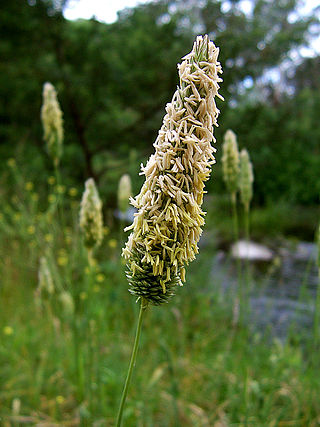
Poaceae or Gramineae is a large and nearly ubiquitous family of monocotyledonous flowering plants commonly known as grasses. It includes the cereal grasses, bamboos and the grasses of natural grassland and species cultivated in lawns and pasture. The latter are commonly referred to collectively as grass.

Saccharum is a genus of tall perennial plants of the broomsedge tribe within the grass family.
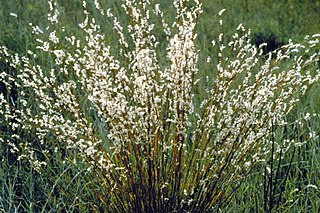
The Andropogoneae, sometimes called the sorghum tribe, are a large tribe of grasses (family Poaceae) with roughly 1,200 species in 90 genera, mainly distributed in tropical and subtropical areas. They include such important crops as maize (corn), sugarcane, and sorghum. All species in this tribe use C4 carbon fixation, which makes them competitive under warm, high-light conditions.

Johnson grass or Johnsongrass, Sorghum halepense, is a plant in the grass family, Poaceae, native to Asia and northern Africa. The plant has been introduced to all continents except Antarctica, and most larger islands and archipelagos. It reproduces by rhizomes and seeds.

Bothriochloa is a common and widespread genus of plants in the grass family native to many countries on all inhabited continents and many islands. They are often called beardgrass, bluegrass or bluestem.

Themeda is a genus of plants in the grass family native to Asia, Africa, Australia, and Papuasia. There are about 18 to 26 species, many of which are native to Southeast Asia.
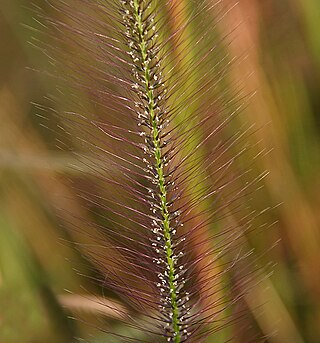
Perotis is a genus of Asian, African, and Australian plants in the grass family.

Calamovilfa is a genus of North American plants in the grass family native to the United States and Canada.

Chionachne is a genus of Asian, Australian, and Papuasian plants in the grass family.

Distichlis is a genus of American and Australian plants in the grass family. Plants in this genus are dioecious, have rhizomes or stolons, and have conspicuously distichous leaves.
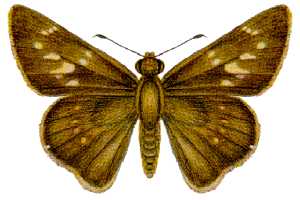
Pelopidas lyelli, the Lyell's swift, is a butterfly of the family Hesperiidae. It is found in New South Wales, the Northern Territory, Queensland and Western Australia, as well as Irian Jaya, Maluku, Papua New Guinea, the Solomon Islands and Vanuatu.

Sorghum leiocladum is a grass plant in the family Poaceae that is found in eastern and northern Australia.

Cnaphalocrocis trapezalis is a species of moth of the family Crambidae described by Achille Guenée in 1854. It can be found from Africa to the Pacific region, including Australia as well as in the Dominican Republic, Mexico and Peru.
Sorghum purpureosericeum is a species of plant in the grass family, Poaceae, that occurs in central and eastern Africa, Yemen and India.

Sorghum × almum, the Columbus grass, is a hybrid species of flowering plant in the family Poaceae. Its parents are Sorghum bicolor × S. halepense (Johnsongrass). Sorghum × almum is one of the most valuable livestock forage and fodder crops during summer in semi-arid and sub-humid areas worldwide. It is considered a noxious weed in several US and Australian states.
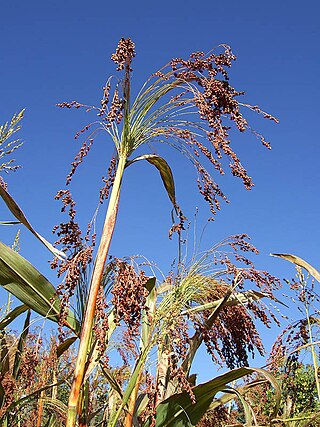
Sorghum arundinaceum, the common wild sorghum, is a species of flowering plant in the family Poaceae. It is native to Sub‑Saharan Africa, Madagascar, many of the Indian Ocean islands, and the Indian Subcontinent, and has been introduced to northern South America, the US states of California and Florida, Puerto Rico, Taiwan, New Guinea, and a number of smaller islands worldwide. It is the wild progenitor of cultivated sorghum, Sorghum bicolor, with some authorities considering it to be a mere variety or subspecies; Sorghum bicolor var. arundinaceum, or Sorghum bicolor subsp. verticilliflorum.
Sorghum macrospermum, the Katherine sorghum, is a species of flowering plant in the family Poaceae, endemic only to limestone outcrops in the Katherine River area of the Northern Territory of Australia. An annual and a diploid, as a crop wild relative of Sorghum bicolor it is being studied for its resistance to various pest species.

Sarga stipoidea is a species of flowering plant in the grass family Poaceae, native to seasonally dry tropical areas of northern and central Australia. It can grow on very poor soils and reaches heights of 10 to 14 ft.
Sorghum virgatum, Tunis grass, is a species of flowering plant in the family Poaceae. It is found across the Sahel region, up the Nile valley, and on to the Levant, and has been introduced to Morocco and Ethiopia. It contributed genetic material during the creation of domesticated sorghum, Sorghum bicolor.

















